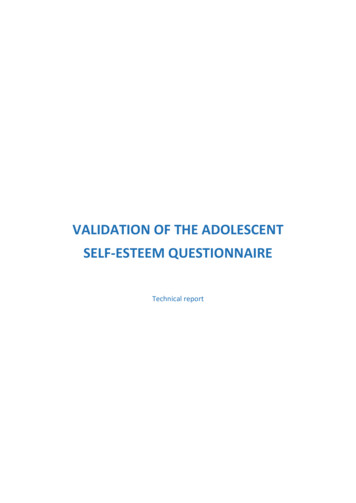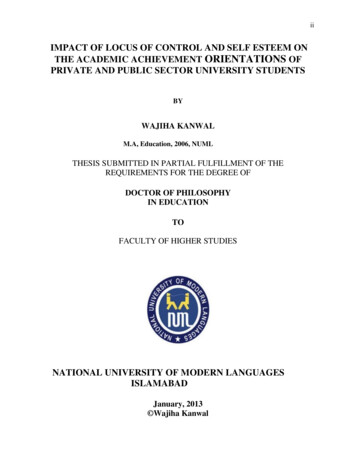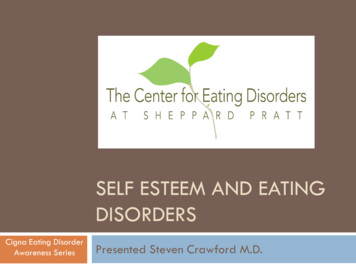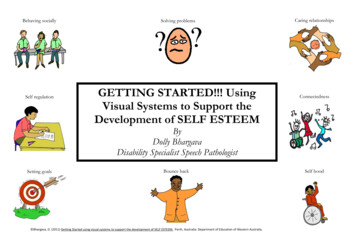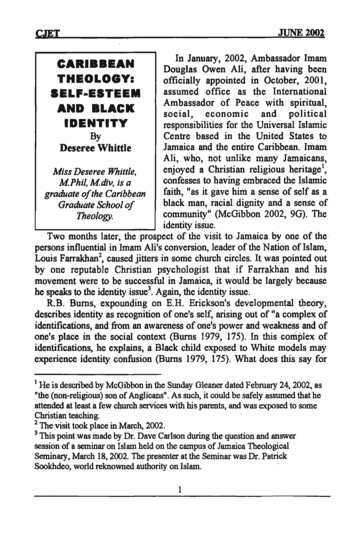
Transcription
JVNE2002.,.,.In January, 2002, · Ambassador ImamDouglas ·Owen · Ali, after '.having beenofficially appointed in October; 2001,assumed office as e InternationalAmbassador of Peace with spiritual,social, economic and politicalresponsibilities for the Universal IslamicByCentre based in the United States toJamaica and the entire Caribbean. ImamDeseree WhittleAli, who, not unlike many · Jamaicans,enjoyed a . Christian religious heritage\Miss Deseree Whittle,confesses to having embraced the IslamicMPhil, Mdiv, isafaith, i, as it gave him a sense of self as agraduate ofthe Caribbeanblack man, racial dignity and a sense ofGraduate School ofcommunity"(McGibbon 2002, 9G). TheTheology.identity issue.Two months later, the prospect of the visit to Jamaica by one of thepersons influential in Imam Ali's conversion, leader of the Nation of Islam,Louis Farrakhan2, caused jitters in some church circles. It was pointed outby one reputable Christian psychologist that if Farrakhan and hismovement were to be successful in Jamaica, it would be largely becausehe speaks to the identity issue3 Again, the identity issue;R.B. Bums, expounding on E.H. Erickson's developmental theory,describes identity as re ognition of one's self, arising out of "a complex ofidentifications, and from an awareness of one's power and weakness and ofone's place in the social context (Burns 1979, 175). In this complex ofidentifications, he explains, a Black child exposed to White models mayexperience identity confusion (Bums 1979, 175). What does this say forCARIBBEANTHEOLOGY:SELF-ESTEEM. AND BLAc:KIDENTITYI He is desCribed by McGibbon in the Sunday Gleaner dated February 24, 2002, as"the (non-religious) son of Anglicans". As such, it could be safely assumed that heattended at least a few church services with his pm:ents, and was exposed to someChristi!lIlteaching.2 The visit took place: in March, 2002.3 This point was made by Dr. Dave Carlson during the question and answersession of a seminar on Islam held on the campus of Jamaica TheologicalSeminary, March 18, 2002. The pres ter at the Seminar was Dr. PatrickSookhdeo, world reknowned aUthority on Islam.1
Whittle: Self·esteem and Black Identity ,the Black childgl"owing up in the Caribbean where the ideal is oftenpainted white or labeled "foreign"?According to Carlson (1988, 34), a firm sense of one's identity inrelation to others is .a' crucialingr dient , for the .developm nt of.a healthyself-esteem. Self-esteem, he says, is n a feeling of being bappy with . apositive and accurate pictureof[oneselfJ a confidence that [one is] okay[as is]", Le. with one's sinfulness yet "forgiveablertess" ,gender,natiomility, race and colour, etc. (Carlson 1988,241);Self. esteem andidentity are'thus integrally linked.One need not look too far to see the devaStating effects of an insecuresense of self and low self-esteem. Of course this is IlOt a problem uniqUe toJamaica or even to the Caribbean. This is what underlies much of societalproblems such as thebreak-down in family life, juvenile delinquency, drugabuse, and ethnic conflicts.in the,Caribbean and beyond. In the Caribbean,in particular, this poor sense of self is largely linked to race and colour.Certainly, . there is no doubt among Caribbean theologians . that Caribbeantheology needs to be addressing issues such as these (Smith 1991, Watty. .'1981} .Caribbean theology,accOl:ding to Smith (1991; 14) isattempt tointerpret the revelations of God within 'thepecu:1iar ' historical,' ethnic,political and 'cultural Context of the Caribbean. In other words" Caribbeantheology, like 'all other theologies, should attempt to apply the universalmessage of God to a particular situation. However, while bemgcontextual,it must avoid parochialism. While mostCaribbean.theologilUls 'coricur onthis POint, .the big question is how.tothis.in th face . ?f,suchdiversities.As Noelliste (1997, 46) points. out,\ fr m a linguistic point of view,one canspeak of atle.a st fiveCaribbeans: the French, English, Spanish, Dutch andCreole speakingCaribbean. WitIii# these. are the different raciaVethnicgroups whichhave .come to be a\ part of the Caribbe : Europeans;and6ther Asiaps, 'plus Varying mixtures 'of all. OneAfricariS, Easflndiof the greatest challenges Of the f1edgl ng Caribbean theology is to keep itapplicable .toall ,the different Caribbeah cultures.(Ham' 4). fortunately thefactors which unite the' Saribbeanare many respects ter than ,thosewllichdivide,it. These include a common history of slayery,emancipation,indenturedlabourandcolonialis . . It is based on this commonality thatthis paperwiU attempt to exploremi·issue, which though a universal one,an40ans .in2
CJETJUNE 2002 .'.-,,-.',"." .',',' .,.' .',. . . . :. . . . . . . . . . : . .0: - . : . . . . : ' . . .: ,' '.has special application to the Caribbean. This is the problem of a negativeself-image.The Problem: The negative self-image of the Caribbean manJosh McDowell (1984) of Campus Crusade for Christ aptly ,defines ahealthy self-esteem. as seeing oneself the, way God does, no more and noless. Most psychologists concur that this is one. of the, .most basic. of allhuman needs (Carlson 1988, 19). Caribbean theologian Kortright Davis(199.0,.1.03), in ,his· discourse on emancipatory theology, has specificallycited this. as the most crucial human need in ,the Caribbean. According tohim,. '. the most crucial human need in the Caribbean at this time .isneither trade" nor aid, nor armS,. nor, even the liberation of the mind, but.rather the emancipation of the "disvalued self'. This disval ed self, ac:cording tohim, is the, product ofa skewed viewof oneself, or a poor self-image. A poor self-image can be shown to be atthe heart of Illany, of the problems facing the Caribbean. Schuller(1982,145), a theologian who, examines .the. issue. of self-esteem from. the doubleperspective of. theology , and. psychology, claims that .at, the root of allsocial, political,. econoIllic, religious, and, even, scientific. problem .', i .theprivate and ,collective need ,for positive pride, or healthy self-esteem.TllOugh this way seem, to be somewhat of an, exaggeration, .it isnotdifficult to see. that the. man lacking in self-pride may also lack theinitiati"eand motivation to even try to contribute to,his own social,politica1.oreconomic well-being.,. WithintheCaribb an,thispoor selfimage, along with the .corresponding poor view of others, .is manifested inthe,political a.l1d.businessethos whereby power and profits .are placedabove humanJife, in the unstable family life,.in the, ethnic. and social classtensions, and in the, hopelessness experienced in theslwns.Caribbean history has not been condlJcive to engendering of aposit veself-image in the, Caribbean people, pAfticularlYamong thebl",ckIllajority.One legacy of the plantation system js ,a sense of racial .and culturalinferiority. am.0Ilg Blacks. In the laveand,· post-eIllancipation s()ciety,soc:ialstandiIlg was based on skin col()ur. Whites were. at .the top of thesocial ladder, Blacks at the bottom, and various shades of Browns in3
Whittle:Self esteemand Black Identitybetween. This state ofaff"irs .was buttressed by religiousideo!ggiessu,chas the curse of Ham, as, \\iell as by the denigr"tion of. Afric" .and theAfrican cultural heritage (Chevannes 1995,10). . History tells us 'that whenthe East Indian,s and other AS,ians joined the Caribbean landscape theyfound a place in the already established colour scheme, in which theAfrican descendants remained at the bottom (Henriques 1963).More than 150 years after the abolition of. slavery, vestiges of thissocial structure remain, as evidenced in the racial/ethnic tensions and inthe child socialization. , If much of the overt emphasis on colour incountries like lamaicahasgiven way to a focus on class, with wealth asthe principal determining factor, the covert hierarchical colour schemecontinues. Blacks, especially, still struggle with elf-hate and selfdepreciation . It is not difficult to understand that this group would be mostseriously affected bya poor self-image when one considers that unlike theother ethnic groups ·whp .were able · to maintain .links . with their culturalheritage, the ,African ' descendants were forcibly ' alienated from ·their roots(Reddock 1998, 420). According to Reddock (l998 418), TrinidadiansofAfrican descent still struggle to have their African cultural identityvalidated by the dominant culture;Of course, it would be too simplistic to claim that all the Caribbean'sproblem with low self-esteem is d,ueto the colour or racial factor. As wasmentioned above, other criteria used in the assessment of self-worthinclude material wealth and power. Dr., Eisa Leo Rhyi e (1993, 16) hasalso noted that the e.xcessive use of negative feedback of whatever' type inthe socialization process usually lead to a poor self concept and low selfesteem. However, colour and race are still major contributing factors tothe Caribbean self- mage, and are ,factors which,have 'been by and largeneglected by the Caribbean ·Church. It is for all these reason ,that thispaper seeks to zero in on the self-esteem issue with special focus 0 1 theCaribbean Blacks who comprise about 70 percent of. the Caribb,eanpopulation.Self-esteem and Caribbean;theologyFor many Caribbean theologians, a h althy self-esteemneedsto .be,oneby-product of doing theology"from a Caribbean perspective. According to'Smith, Caribbean theology should aim at producing "a .new Caribbean4
JUNE 2002person with a m()re healthy self-concept" (Smith 1991, 13).According toWatty, for whom Caribbean theology is one ()fliberation,Liberation . in the Caribbean, is primarily and essentially aliberation of the mind, both fromself-depreciation and imitationon the one hand, and from dreaming the impossible dream on theother hand. (Watty 1981,49)Nevertheless, not much has been done .to articulate a theology thatwould bring about such a liberation. The best attempts have come from thecamp of the Evangelicals. Palmer (1998,84), in addressing the question ofthe nature of the .·Christian, makes the point that though the Christianstruggles with human depravity, he should not be viewed as such, butrather asacreature .()fdignity and destiny based on the present imago Deiand the future imago Christi (1 John 3:2). This focus is one step insteering, Caribbean Evangelicalsaway from a negative self-image, whichmay be due, according to American evangelical 'theologian, AnthonyHoekema, to the emphasis ·on the .sinfulnes8.,· and unworthiness of man inthe presence of God (Venema 1993, 283), McGrath, a leading BritishEvangelical, has chargedthatthis · is ·one weakness among Evangelicals ingeneral. According to him, the preaching and counseling styles amongEvangelicals ,are such that, they induce excessive guilt in the hearers,thereby destroying human self-confidence and any sense of personal worth(McGrath 1988, 148).Noelliste, in his article Faith transforming context: n search ,of atheology/or a viable Caribbean, posits as the basis for self-worth,regardless of race or class, the twin biblical concepts of creation andredemption ,(Noelliste 1997,54-56). This view focuses on the unity orallmankind in spite,of the diversity. However, I believe there is alsone,ed,toaffinn the diversity within the unity. Indeed, it is insecurity about thediversity which is at the root of evils like ethnic cleansing in Yugoslavia,apartheid in South Africa, and even religious ideologies like the curse ofHam. However, (}od has no problems with diversity.)uther as the authorof all creation, he endorses it(Gen. 10). At the birth of the Church in Acts2, God ·shows his approval and respect for ' diverse cultural and ethnicgroups, firstly by having them present, and secondly by providing specialtranslation for·them. In the case of the Caribbean, especially in the caseof5
Whittle: Self-esteem and Black Identitythe Black populationw.ho has suffered so much discrimination. anddehumanization on account of their skin colour, there is also need.to affirmtheir particularities. If Caribbean theology does not deal specifically withthe affirmation of the black man, then it would have failed in one vitalarea.I pause here to consider the .Rastafarians' . approach to the self-esteemproblem for two reasons. Firstly, they are one of the fewgroups in theCaribbean to have directly addressed this problem. Secondly, it is thoughtby .several Caribbean theologians that at least some aspects of their view isindispensable for the construction of Caribbean theology (Hosang andRingenberg 1982, 16; Murrell and Taylor, 1998,390).Self-concept and.The RastafarianRastafarianism, born in the slums of Kingston in. the 1930s, has nowbecome a Caribbean, as well as an international phenomenon CV an Dijk1998, 178-195). It is a movement of resistance with the aim of reestablishing thetost cultural identity and dignity of the Black man(Edmonds 1998,23). According to Dennis Forsythe, Rastafarianisin is thefIrst mass movement among We t Indians to be preoccupief with thequestion of Black identity (Edmonds 1998; 30). They have completelyrejected ;WesteIll · · colonial teaching . and replaced it . with .their ownideologies which reaffinn the Afri91iD heritage . . Their theology .affirmsthat God or atteast the Messiah, is a black man in the personaf the lateemperor of Ethiopia, Haile Selassie. They also view many ·of the biblicalpersonalities, such·as Solomon, the Queen of Sheba and even Jesus asBlack. . They see . themselves as the Jews reincarnated (Murrell andWilliams1998,329-344).They proclaint the.dignity ofthe Blac man, forsince he was made in the .image . of God, he possesses divinity .(Owens1973, 165). This dignity is expressed theiisymbols like the dreadlocks,Ethiopian colours, and dread talk. In s way they have sought to Undothe damage done to the Black self-image.Earlier this year, during the visitof er Majesty, Queen ElizabethII toJamaica, the Rastafarian community presented her with ·a·petition seekingreparation - compensation for slavery - and repatriation - assistance toreturn to Africa (Bell 2002, 6A). This was a cry or reparation of a gross6
.JUNE 2002. ' ,C.JET ,-·· . ":::;' ;: :C,'·.".' :, ,,"-irijbstice "committed against the ' ancestors of the African Caribbean. poPldationover ISO years ago. Ilis really a quest fora restoration ofdignity and self-worth to the largest ethnic population of the .Caribbean.Wouldn't it be nice if it were the ChUrch,which represents such a largeproportion of the Jamaican people, leading such a campaign? Perhaps theCaribbe Church has not yet articulated the. theology required for· such.amission. The 'Rastafarians' theology, ' although it represents a valiantattempt, sadly cannot get to the root of the problem, as it is built on afouridationoferror. A trlliy liberating irleologyneeds to be based on truth(John 8: 36) ' This is the sort of theology the next sectionwill attempt todevelop.TowardaC ribbean theology of self-esteemFoundation,O n what basis. can a .Caribbeantheolqgy of self-esteem be built? On, the doubl foun ationoftpe biblic.a lconcepts of creation and redemption,as PUIJl9rtS. N lliste (l997). ?. . . .''.'. TheScriptures .declare .that man as created in the image of God andthat God'sevaluat onoftpis .creation was that it was good.(Gen. 1:27-31).This.image,iwe; are assured, has .contipued even after: the fall (Gen. 9:6). .Sin.ce . all hWl1. ty . .rup fromone , t11enthe. creation'.narrative placesall meJl on .equa:Ifo()ting,andconfers on ali:persons of all races and socia:I, clas.ses the divin tamP . of appr()va:I(Noelliste .1997, .54). The .concept of iedemptionand the "new creation"declares the high. value:God .places ona:I1 men .To ,redeem mankind, the highest possible' pricewas .pa.d- . that of blood (1 Pet. 1:'18; LCor. 6:20). The value of man. Js · xPressed in the cross"iFurth.ermore, Gala ans 3:28 makes it cle.ar that as, far . 'place .andpositi()llin,the ne . creationare ,conqefl1ed,racial , socialand gender distinctions- often divisive factors in this. world. - aI"e of noimportance. Thus, creation and .redemption affmn the intrinsic, ontologica:Iworth dequa:Iityofall hUlllBll heings, regardless of status, race or cre .This value needst() be . emp4asized in Caribbean theology. Carjbbeanth ()logy needs to sho\\, the s cificexPression of the image of God inBlacks, and also go further to affirm and give positive status to just thoseas7
Whittle: Self-esteem and Black Identityelements which were regarded as objects of shame, particularly theAfrican heritage and the physical features unique to Blacks.The Image of God and the Black Man'In exploring the .question of how the image of God is expressed inhuman beings, Brand and Yancey (1984, 20) point oufthatphilosophersand theologians·have·tended to define the· image of God in accordancewith the principal concemof their era. Thus, the Enlightenment thinkerssaw the image of God in the ability to reason, the Renaissance thinkers inthe capacity for artistic creativity, and so on. These aspects of.God's imageare universal, i.e. present in all mankind, regardless of race, class orgender. How does this apply specifically to the. Caribbean man? Thissection will explore.·llie manifestation of this unage .in his creativity, workand culture, and his physical.attributes.Creativity. One aspect of the image of God in the Caribbean man may beexpressed in.the Jamaican.proverb: ''tun yu han mek fashun" . This·sayingexpresses not only artistic creativity,but also creativity in the face oflimited resources and often difficult circumstances. This creativity hasbeen the basis of survival for many persons living under harsh economicconditions. This is a God-given quality/ which needs to be lauded andencouraged. This is what the Apostle/ Paul was .expressing when hetestifiedI· know what it is to be in need, and I know what it is to have plenty. Ihave learned the. secret of being content in any and every situation,whether wellfed or hungry, whether living in plenty or in want. J .can doeverythingthroughhim who gives me strength. (Phi!. 4:12-13, NIV). The single mom living in the inner-city, who, on a domestic helper'ssalary, manages .to school and. feed her children, needs to understand. thather ingenuity is an expression of the image of God .in her. Caribbeanpeople can take pride in the fact that they have this special manifestation ?f God's image.8
JUNE 2002Work 8nd·CultureThis creativity is of course, linked to work and culture, anotheruniversal expression of the image of God. In Genesis 1:28, man wasinstructed to "fill the earth and subdue it", and to rule over all the livingcreatures. The fulfillment of this mandate would involve creative use ofthe earth's resources, gardening, farming, management and supervision. InGenesis 2:15, the same mandate is expressed differently, as man is placedin the Garden of Eden and is told to "work it and take care of it". Thismandate, often called the cultural mandate, was giv'e n before the fall. ' Themyth ofworkas 'acurse resulting from the fall needs to ·be dispensed with.The exercise of any form of work is in fact, ' a point of identification withthe Creator,who worked for six days at creation and then rested on theseventh.Insofar as culture represents a specific group's way of "subduing theearth" ,then all cultures,reflect aspects of God's image. Hiebert (1983, 25)in Cultural Anthropology defines culture as "the integrated system oflearned patterns of behaviour, ideas, and products characteristic of asociety." Though tarnished at the fall, and certainly in need of redemption,all cultures, including the African culture, continue to bear aspects of thisimage. The positive aspects of the African heritage, such as the storytelling tradition, the affinity for the, bassrhythIIl,and artistic creativity,need to be embraced as expressions of God's image.Physical AttributesThe Rastafarians .are not ,wrong in emphasizing the physical attribute ofcolour as a part of the image of God. Though by far, not the mostimportant ·aspect, it is ,nevertheless an important aspect. Man, created inGod's image,was notonly souL He came in a physical body. The historyoutlined in Genesis '1-1 1 shows hOw all the different races 'developed fromthe first image bearers - Adlllri and Eve; From this, it can be deduced thatthe physical features of all races, much like a kaleidoscope, all reflect theimage of God.' Thisinc1udesthe Blackrace. Although this position affmnsa link withGod,itdoes not lead us into the error of recreating GOd in ourown image and positing a black god. 4,'This is what the Rastafarians do. This kind of reasoning would logiciilly lead to agod for each race, which would of course be absurd.4
· ; Whittle: Self-esteem and Black IdentityFurther, Scripture shows that God affirms and validates the.Black manin particular. They are replete with references to Black people, more oftenthan not in a pOsitive light. These include Ebed-Melek, Jeremiah's friend(Jer.28:7-13), "the mighty men of Ethiopia and Put who handle the shield"(Jer. 46:9), and perhaps evert Zephaniahs, one of the MinorProphetsin theOld Testament. In the New Testament, there is the Ethiopian eunuch whowas converted and baptized.by Philip (Acts 8).Curse ofHamYes, there is still the question of what to do with "the curse of Ham",generally accepted to be the father of the Black race (McKissic. 1990, 16).Because this curse has throughout history played such a powerful role ininstilling a sense of inherent inferiority in Blacks, it would need to bechallenged in Caribbean Theology. Two important points need to be madehere. Firstly, it was Canaan, Ham's fourth and youngest son, who wascursed, and not Ham 'himself (Gen; 9:25.,.27). Ham had three other sonswho apparently were not included in this curse (Gen.lO:6). In fact, thebiblical author pauses in his listing of the descendants of Ham (which hedoes, not do for the Japhethites or the Semite) to highlight the great feats cifNimrod, the son of Cush, Ham's first son (Gen. 10:8-12). Hardly like oneunder a curse, he is described as "a mighty hunter before the Lord" (Gen.10:8).Secondly, biblical curses generally lasted until the third or fourthgenerations only (Ex. 34:6-7). This means that the curse, whoever was therecipient, would have already ceased t operate. The favourable Blackpresence in the Scriptures seems to bear this out. The biblical evidence,therefore does ·not support any black inferiority based ' on the account ofthe so-called curse of Ham.Identification with the 'MessiahGiven that self-identity develops out of "a coinplex ofidentifications"(Burns 1979, 175), it is important to note that God, through the Messiah,identifies with the Black man, as )Vithany other group 'of oppressedpeople. The "Black Christ" is not necessarily one who came in a blackS'In Zeph. I: I, the prophet is desCribed as the son of Cushi, a termsome\imes usedin the Bible to refer to Ethiopians or Africans.10
.JUNE 2002CJET.,g y, but \() e whoidentifies with the suffering of the Blacks (Isaiah 53,He'' '' i1:15). .Blacks can therefore identify with Christ in this way, andincorporate this into their identity. Thisis the kind of identification theApostle Paul describes in Galations 2:20 when he says "I have beencrucified with Christ. ;"Thus, the Afro-Caribbean man can be affirmed firstly because he isincluded in the "every race" which bears God's stamp of approval andsecondly, because of the specific manifestation of the image of God inhim. He can take pride in Christ's identification with blackness· and theBlack presence in Scriptures. All this would need to be.included in aCaribbean theology of self-esteem.ApplicationThe Salvation messageThe.starting point.Most Caribbean persons, particularly those of African descent, alreadyhave a poor view of themselves. Sam Vassel (1997, 84), in his dissertationon the absence of men in Jamaican churches makes ·this observation .ofJamaican . mel1. uch .persons do not n edtoomuch persuasion .to '. beconvinced of their utter unworthiness before a.holy God. What would .takemuch ,more work is to convince them .that this holy God could take. interestin them and find them valuable as individuals, when all ·their lives they .grew up hearing and believing how worthless they were. As Schuller(1982, 150-51) contends, this is the news that needs to be placed at theheart of the salvation In ssage.· .'. '.;". .:.Parallels with Caribbean historyJust .as God repeatedly commanded the Israelites to remember theirhistory, he wants us to also remember our history. Black history needS tobe mentioned wh n talking about God's plarifor mankind arid God's 'control ofhistory.'. . .'11
Whittle: Self-esteem and Black IdentityOur Caribbean history does have striking parallels with·the Jewish historyrecorded in the Bible, and the Rastafarians have made use of these, Thus,drawing on the similarities of the suffering and the exile, they seethemselves as incarnated Jews. The Church can also make use of suchparallels. We must preSent a Christ who is ·acquainted with suffering andgrief'. Rather than speaking about "saving souls" we can talk aboutemanCipation, and not just of the soul but of the whole man. In this waywe.draw on our history of slavery and emancipation.Positive Work Ethicthe association of hard work with slavery must be challenged. Theexercise of any form of work, be it cleaning toilets, farming or managing abusiness, does not lower one's self-worth. On the contrary, as anexpression of God's image, it reflects dignity.The Re-valuation of things blackAs mentioned above, one strategy used in the deliberate deculturizationof the Blacks brought to the Caribbean was the denigration of Africa andthe African cultural heritage, as well .as of Black physical features. Atheology which sees both the African culture and the physical featuresunique to Slacks as expressions ·of the image of God adds value to thingsblack. One deliberate way of re-culturizing our people in terms of thevalue ·of things black is to point out references to Africa and Blacks inScripture during the proclamation of the Word. Perhaps not too manyCaribbean Blacks have given thought to the fact that Jesus spent a numberof his childhood years in Africa (Matt. 2: 13-15). Specific mentions aremade in the Bible of African countries such as Ethiopia and Egypt (Psalm68). Although these names may not refer to the s e geographicallocations that they do today (Chisholm 1990), they nevertheless refer toplaces on the African continent The names of a number of Black personsin Scripture have already been mentioned above.Ina culture of beauty contests, where standards of beauty are largelybased oh Caucasian features, Blacks need to learn that their blackness, -12
JUNE 2002CJETthe dark skin, woolly hair, spread nose, etc . .:. is anexpressioh'of;God'simage, and is beautiful and acceptable.Conclusion" ',.'.This paper has explored a very small slice of Caribbean theology, atheology of self-esteem, especially as it relates to the Bla kpo'pi4;atlon ofthe Caribbean. We have shown that a firm. sense of black idtmtlty fdtindedon creation and redemption is crucial to the rebuilding of the self-esteemof this racial group. This was by no means an effort to sideline the otherethnic groups, but rather, in view of space and time limitations,; tc(giveadequate focus to the section of the Caribbean population believed to bemost acutely afflicted ' with the problem of a negative .self-image. It .ishoped that as Caribbean theology grows, other theologians will see theneed to focus on the sections of the Caribbean population. The challengeof course, is to get such a theology to filter down in the general teaching ofthe Church. I believe that when the Caribbean man begins to have a morepositive view of himself, the effects will not only be individual, but sociaLFamily life, the corner stone of any societY would certainly improve.Every ' other facet of life, including the financial, poiitical, judicial andmoral aspects, would also be positively affected. It is ' my ' hope that thispaper will pave the way for further exploration on the part o(Caribbeantheologians in this vital, but alas, neglected aspect of Caribbe@l1theology.13
.' , Whittle: Self-este,:m and Black Identity" REFERENCE LISTBarrow, ChristiIie: 1998. Caribt ean asculinityand family: revisiting'marginality' and 'reputation'. In Caribbean Portraits, ed. Christine, ijarrow, 339 358. ingston: Ian Randle Publishers.Bell, Klao. 2002. Rastas use diplomatic route. Sunday Gleaner, Feb 17.""Brand, Paul arid Phllip Yancey. 1984. In his image. Grand Rapids:Zondervan Publishing House. Brow, 'Robert, 1973. The .curse of Ham: cap ule of ancient history.Christianity Today (OctoJJer 26): 8-10.Burns, R. B. 1979. The self concept. London: LongmanGroupLimited.Carls ;m, David. 1988. Counseling and self-esteem. Edited QY Gary R.CoHins. Dallas: Word Publishing.'Cheyannes, Barry: 1995. Rasta/ari: roots and ideology. New York:- Syracuse University PreSs.Chisholm? Clinton. 1990. Rasta/arianism evaluated. Excerpts read by theauthor. Cassette.Davi ,Kortright. 1990. Emancipation still comin': Explorations inCaribbean theology. New York ,Orbis Books.Edmpnds, Ennis B. 1998. Dread "I' in:-a-Babylon: ideological resistanceand cultural revitalization. In Chanting down Babylon, ed. NathanielSamuel Mm-reil, WiIliam David Spencer and Adrian Anthony",McFarlane,,23-34.Philadelphia: Temple University Press.Felder, Cain Hope. 1990. Troubling biblical waters: race, class, andfamily. New York: OrbisB()oks.14,\
.rum: 1001ru;THam, Adolfo. 1995. Caribbean theology: the challenge of the twenty-firstcentury. In Caribbean theology: preparing for the challengesahead, ed. Howard Gregory, 1-6. Kingston: Canoe Press.Henriques, Fernando. 1963. Family and colour in Jamaica, 2d ed. London:MacGibbon and Kee Limited.H
the Caribbean self- mage, and are, factors which, have' been by and large neglected by the Caribbean ·Church. It is for all these reason ,that this paper seeks to zero in on the self-esteem issue with special focus 0_1 the Caribbean Blacks who comprise about 70 percent of. the Caribb,ean population. Self-esteem and Caribbean;theology


